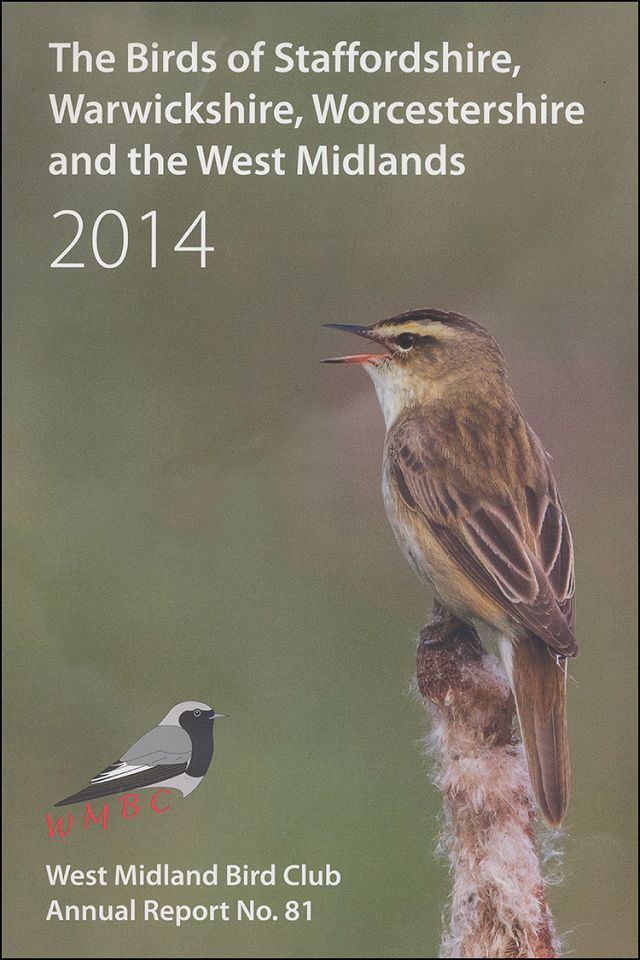The Birds of Staffordshire, Warwickshire, Worcestershire and the West Midlands 2014
 A great deal of information is encompassed within the latest West Midland Bird Club annual report. This 290-page review presents the sightings and counts for each of the four counties, while tables are used to good effect for condensing data on topics such as breeding territories, higher level stewardship farm studies, Barn Owl breeding information for 67 monitored sites, WeBS counts, visible migration totals, monthly maxima and so on. The region produced a total of 229 species in 2014, with Pacific Golden Plover being new to the recording area and bringing the total to 344.
A great deal of information is encompassed within the latest West Midland Bird Club annual report. This 290-page review presents the sightings and counts for each of the four counties, while tables are used to good effect for condensing data on topics such as breeding territories, higher level stewardship farm studies, Barn Owl breeding information for 67 monitored sites, WeBS counts, visible migration totals, monthly maxima and so on. The region produced a total of 229 species in 2014, with Pacific Golden Plover being new to the recording area and bringing the total to 344.
The species order and scientific names follow the latest British Ornithologists' Union (BOU) revisions up to 2016, and a helpful index is found at the rear. The species accounts include a brief status description, and for rare or scarce birds the number of years recorded in the preceding decade. The accounts make excellent use of the club's comprehensive dataset and include both long-term and eight-year average arrival and departure dates for the area's summer visitors.
Very good summary tables are used wherever reasonable, and the species accounts then follow a pattern of each county's records being presented in typical bird report fashion. Each of the four counties have their own records committees and team of report writers, and in some respects it does appear that four reports are being compressed into one, with differing styles of presentation quite apparent; for example, Staffordshire makes much more use of tables to summarise information, while other counties list all known sites (Spotted Flycatcher being typical). The Common Buzzard and Kestrel accounts show very contrasting styles and length, but this varied approach may be deliberate and possibly intended to help the reader.
A mixed approach is also evident in the Ruddy Duck account, where two counties provide the site names and two do not, presumably with the intention of helping evade efforts to cull what was once the club's mascot species. It is quite a while since I have seen so many site names being withheld for reasons of confidentiality, but here we have a few anonymous locations for Nightingale, Dartford Warbler and Cetti's Warbler, no doubt respecting someone's wishes. In the Dartford Warbler account, mention is also made of the "usual locations on Cannock Chase", but no records are included.
Having said that, there is a huge amount of information and detail in this report, which I like, but the compressed style of no paragraph breaks within the species accounts would better fit the larger B5 format. One artist and 15 photographers have contributed some fine work which has helped break up the text a great deal.
A very helpful map, extensive gazetteer, four county lists (in one table), an interesting ringing summary and an article on 'apparent Siberian Chiffchaffs with Common Chiffchaff call and 'mixed' song' are also included. I also think that the three 'firsts' deserved their own write-ups, with Bonaparte's Gull (first for the West Midlands) and Hume's Warbler (first for Warwickshire) being confirmed in addition to that Pacific Golden Plover.
Copies cost £12 plus £2 p&p and can be obtained from the West Midland Bird Club by emailing secretary@westmidlandbirdclub.org.uk for details.
More info
• The Birds of Staffordshire, Warwickshire, Worcestershire and the West Midlands 2014 edited by David Emley (West Midland Bird Club, Castle Bromwich, 2017).
• 290 pages, more than 70 illustrations.
• ISSN 14762862. Pbk, £12 plus £2 p&p.

